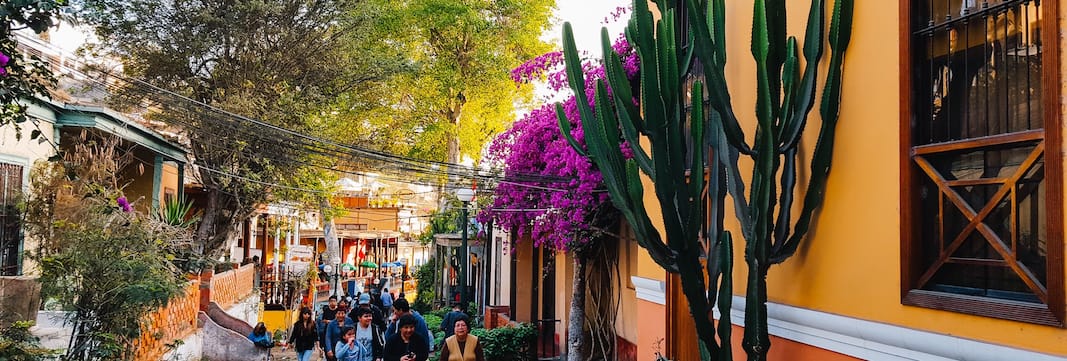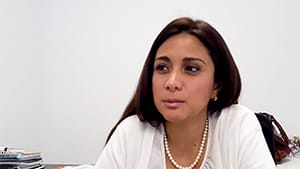Peru
Introduction
«Peru is a beggar sitting on a treasure chest»In 2018, Peru had a population of almost 32 million and an economic output of 222 billion US dollars. According to the World Bank (2017), an average income per capita of just over USD 6 000 corresponds to the country's classification as a middle-income country in the upper range. Peru ranks 89th in the United Nations Human Development Index. Measured in terms of life expectancy, educational level and standard of living, the country is thus attested to a high level of human development. However, the Gini coefficient of 43.3% (2017) makes it clear that Peru has considerable income disparities, even if these are not quite as pronounced as in other Latin American countries.
In 2018, Peru's foreign trade ratio was 49.0%, with the country importing just under $53 billion in goods and services and exporting $56 billion. In the same year, foreign direct investment in Peru amounted to USD 104 billion, accounting for 6% of the country's investment in Latin America.
On Transparency International’s corruption perception index (2019), Peru ranks 105th of 180 countries, and is thus considered a country with a high susceptibility to corruption in the public sector. According to Human Rights Watch (2017), civilians have been repeatedly injured and killed by security forces in protests against mining projects and major infrastructure measures in recent years. It should be noted, however, that violence has declined recently. Journalists investigating corruption by public officials and businessmen, however, are covered up, intimidated and threatened with libel charges. Reporters Without Borders notes, however, that in 2018, no journalists were killed and one was arrested in connection with their activities. In the press freedom ranking, Peru ranks 85 out of 180 countries.

75% of the population’s municipal waste (2001) is collected and 15% therof are being recycled (2001). In 2015, 89.9% of Peru's population had access to basic drinking water services, with a significant gap between urban (94.6%) and rural (72.4%) areas. It should also be noted that only half of the population was supplied from safe drinking water sources (50.2%). According to the latest figures available, 81% of the population is connected to the sewage collection system (2009).
With per capita emissions of 2.0 tonnes, Peruvian CO2 emissions are below both the high average level of 5 tonnes and the regional average for Latin America of 3.1 tonnes per capita.
The following sections provide examples of the challenges facing companies in Peru in the areas of human rights/working conditions, the environment and corruption. In addition, examples are given of how companies can shape their responsible corporate management in concrete terms.

Human rights
«There is no serious discussion of human rights in Peru»In Peru's most poor and inaccessible mining regions, the conflicting interests of the local indigenous population and the mine operators clash. In the countless small gold mines, hazardous working conditions and illegal working and mining methods are the order of the day. These include the improper use of mercury and cyanide to bind the gold, but also various forms of forced labor. In industrial mining, which is operated by large, mostly multinational companies, working conditions and ecological standards are generally better, but there is still considerable potential for conflict in large mining operations. Conflicts over land and water, illegal or involuntary resettlement, environmental pollution or the excessive use of local infrastructure are just some of the reasons that repeatedly lead to sometimes violent conflicts.
There are also active police officers who work as second jobs for private security services in mining companies to improve their low state salaries. This dual function increases the potential for conflict with the local population, who have the impression that the police only represent the interests of the mining companies and are not there to protect the population. When companies engage private security services, for which active police officers work, they must ensure that there is a clear separation between the different functions of the people hired.
When trading in small-scale mining raw materials, international companies have a responsibility to ensure that human rights and environmental standards are respected along the value chain.


Environment
«Alone we are just a candle, together we shine much stronger»Peru is one of the most important mining regions in the world. In many cases, mining is associated with considerable environmental pollution and destruction. The improper use of mercury and other toxic substances is still widespread, especially in informal and illegal small-scale mining. The consequences of this are polluted rivers and groundwater, contaminated air and soil, which burden the livelihoods of local smallholders and indigenous peoples or even destroy them forever.
There are few controls by the state. On the one hand, there are hardly any access roads to the mines, as they are mostly located in remote rural areas, and on the other hand, the state and individual public officials benefit financially from mining. Therefore, they have no particular interest in carrying out strict controls.
Companies therefore have a responsibility to take appropriate measures to counter environmental degradation. The Swiss Better Gold Initiative is a development initiative in the field of small-scale mining that aims to make the mining and trading of gold more socially and ecologically sustainable. In addition to improving social conditions in mines and cooperatives and creating transparency in the value chain, the initiative aims to reduce the use of environmentally harmful technologies. For example, there are various ways to minimize the use of mercury, for example, by using vibrating machines to remove the gold from the stone.


Corruption
«Corruption causes more damage than a natural disaster»Everyday corruption is also an issue in Peru. It manifests itself in the bribery of police officers on the street corner or at roadblocks. In traffic accidents, for example, a bribe is given to the police officer responsible to “forget the matter” - in Peru, this is called “arreglar”. But also in the construction sector, criminal up to mafia-like structures are present. Companies sometimes make informal payments to the construction workers to ensure that the building materials, such as wood, paint and bricks, are still available the next morning and have not been resold by the workers. Many companies are in this corrupt cycle and are paying because they don't want to risk being without building materials.
In the meantime, however, more and more companies are defending themselves against widespread corruption. Especially among the young generation of entrepreneurs, the view is prevalent that corruption is not a trivial offence and that, in the long term, there are no winners but only losers. For example, they no longer take part in tenders where they know that they cannot get ahead without informal payments. They want to get their contracts honestly.
A merger of companies that are allying themselves against the vicious circle of corrupt machinations could help to tackle corruption in Peru with joined forces and fight it in the long term.

Conclusion
